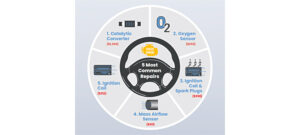New vehicles are critical to the aftermarket in at least five significant ways, ranging from the average age of vehicles to the annual miles of different vehicle age groups
Fort Wayne, Ind.—At the beginning of 2023, 9 million fewer cars and light trucks 5 years and under were on U.S. roads than in 2018. This reversed the trend of an expanding new car and light truck population beginning in 2014, as the recovery from the Great Recession of 2008 gained momentum.
New vehicles are critical to the aftermarket in at least five significant ways, ranging from the average age of vehicles to the annual miles of different vehicle age groups, according a study by The Lang Marketing Aftermarket iReport.
The new vehicle market fell to 14.4 million in 2020, down from 17.0 million the previous year. Vehicle sales continued lower during the next two years, bottoming at 13.9 million in 2022. Lang Marketing expects the robust pre-2020 annual new vehicle sales levels will not return before 2027 or later.
Here are the key takeaways from the analysis.
Newer vehicles impact the aftermarket in at least five significant ways
• The number of newer vehicles helps to determine the average age of all vehicles in operation (VIO).
• The number of newer vehicles determines the population of the critical repair-age sweet-spot (vehicles aged 6 to 10 years old), which brackets cars and light trucks with the highest rates of annual usage across many aftermarket products.
• New vehicles are a key market for many types of accessories, as new vehicles are often modified to fit the lifestyles and usage needs of their buyers.
• Vehicles five years and newer have traditionally been the primary source of dealer service bay business.
• Fewer new vehicles (which average the highest annual mileage) means that older vehicles are driven more yearly miles.
The influence on the aftermarket of fewer younger vehicles will be critical in its development to 2030 and beyond.
Vehicle Average Age
Two factors determine the age of vehicles on U.S. roads: new car and light truck sales and the annual scrappage of vehicles in operation.
As the annual scrappage rates have trended down due to more durable vehicles and people keeping cars and light trucks longer, the new vehicle market has become ever more significant in determining the age of the VIO. With the decline of car and light truck sales that began in 2020, the VIO’s average age has increased steadily. Lang Marketing expects the VIO average age will continue to climb for several years.
Size of the Repair-Age Sweet-Spot
The repair-age sweet-spot, vehicles 6 to 10 years old, represents cars and light trucks with the highest rates of aftermarket use across many products. Lower new vehicle sales will reduce the population of the repair-age sweet-spot in the coming years.
By 2030, about 10 million fewer cars and light trucks will be 6 to 10 years old than in 2025. Some may think this will cause a decline in aftermarket product volume.
Accessory Sales
Many accessories record their greatest sales among the new vehicle population, as buyers modify new cars and light trucks to meet lifestyles and vehicle use needs.
The negative impact of the low new vehicle market on the sales of selected accessories was offset somewhat in 2020 and 2021 by the government’s widespread distribution of billions of dollars in stimulus checks, which many consumers used to purchase accessories.
Dealer Market Bays to Older Vehicles
Vehicle dealers have traditionally marketed their service bays to vehicles 5 years and under. The sharp reduction of this age group since 2020 has caused many dealers to refocus their service bay activities across an older mix of vehicles.
Light vehicle repair market competition will climb as dealers increasingly market their bays to older vehicle age groups, which traditionally have gravitated to independent repair shops.
Mileage Shift to Older Vehicles
Newer cars and light trucks average more annual miles than older vehicles. When the size of the new car and light truck market declines, consumers use older vehicles rather than replacing them with newer ones. This causes a shift in heavy annual mileage to older vehicles.
Since older vehicles use more aftermarket products per mile than newer ones, this mileage shift leads to more wear and tear on the aftermarket parts of older vehicles. It increases aftermarket product use.
Future Developments
The impact on the aftermarket of the shrinking number of vehicles five years and newer will significantly impact the annual volume of aftermarket products, where products are purchased and installed, and how they are distributed.







Comments are closed.